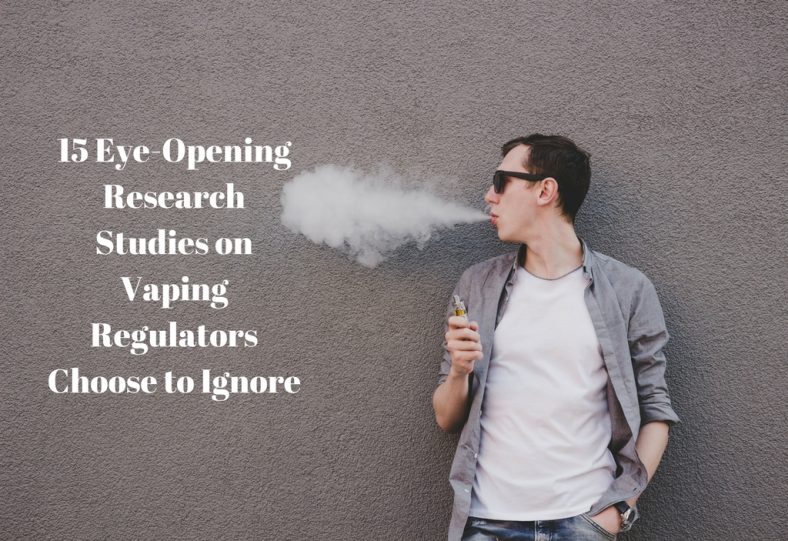It is merely over a decade since electronic cigarettes first hit the market.
Since then, they’ve gained prevalence all over the world. Nonetheless, this rapid widespread, notwithstanding the potential these devices hold to assist individuals to quit smoking more traditional tobacco products to encourage long-term health, encounters some challenges.
Of course, the biggest problem is the fact that numerous studies into their safety and efficacy have struggled to keep up. Despite such thorough and in-depth analyses and findings, state and local authorities are providing stringent laws and regulations that are inhibitive to the acceptance and consumption of vaping.
Besides, there are a few myths that create a negative perception of vaping and deter potential consumers from using it. However, if you are among those that have taken aback by such baseless, unsubstantiated, and fallacious arguments we now have you covered.
Vaping is free from harmful chemicals, promotes lung function, provides a whole new sensation, and is particularly useful to a specific subpopulation.
Following are reliable studies that underpin this fact by highlighting the benefits obtained from vaping, including substantial evidence, literature reviews, and links to draw the point home for legislators and law enforcers.
Many researchers have shown that vaping tends to be by far safer than smoking, including second-hand cigarette smoke. Despite this, there is still a huge misconception that vaping is as hazardous as smoking.
These myths disillusion regulators and this could be preventing smokers who might otherwise find switching to them beneficial.
Early studies into what constitutes e-cigarettes conclude that vaping juices and the vapor they emit do not contain the same degree of most toxic substances as tobacco cigars.
In fact, the levels of chemicals in e-cigarettes have been shown to be so low that Royal College of Physicians and the Public Health England estimate e-cigarettes to be about 95% safer than smoking.
According to some studies released by a global team of researchers, vaping improves public health. The survey had projected that vaping would help reduce smoking-related deaths up to 21%.
However, the same study warned that very high consumption could potentially amount to net harm.
“It is refreshing to focus on the possible life-extending effects of NDDs when they are used in place of conventional, combustible cigarettes,” E-cigarette researcher Laura Crotty Alexander.
Another study stated that comprehending and disseminating the benefits of nicotine placement, including e-cigarettes, is a critical step towards depleting cases of tobacco-related deaths.
Experts from renowned scholarly institutions substantiate the fact that vaping is not only safer but it also produces nicotine levels that are insignificantly different from conventional cigarettes. This property can help individuals quit smoking altogether since the vape will attend to their craving more safely.
“Our study adds to existing evidence showing that e-cigarettes and NRT are far safer than smoking and suggests that there is a minimal risk associated with their long-term use,” said Dr. Lion Shahab, lead author University College London.
Shahab further added, “This study adds to growing evidence that e-cigarettes are a much safer alternative to tobacco and suggests the long-term effects of these products will be minimal.”
Some studies made comparisons between full-time smokers and e-cigarette-only consumers and found e-cigarette-only consumers had 97% lower levels of harmful chemical NNAL, a component that is mainly associated with lung cancer.
Lausegesen executed the very first studies examining the chemical composition of e-cigarette aerosols. During the activation, the resistance temperature of the tested e-cigar was 54 °C, which is equivalent to about 5-10% of the temperature of a burning tobacco cigar.
Toxic chemicals like carcinogenic polycyclic, heavy metals, phenols, and aromatic hydrocarbons were not detected. Only trivial volumes of mercury and traces of acetaldehyde and formaldehyde were noticeable.
Laugesen examined discharges based on an actual toxicant emissions score and recorded a score of 0 in e-cigarettes compared to a score of 100-130 for traditional cigarettes.
Recently, Burstyn reviewed current information and reports on the chemistry of the liquids of e-cigarettes and aerosols and estimated the inherent risks to consumers based on the workplace exposure standards, that is, Threshold Limit Values [TLVs] (Burstyn, 2014).
After completing a review of all evidence available, Bursting found no evidence available in support of the myth that vaping posed inhalable exposure to aerosol toxins that was material enough to warranty concerns.
The author recommended surveillance of use because of the high amounts of glycerol and propylene glycol inhaled (all of which are not considered as contaminants but rather ingredients of e-juice).
The ECLAT survey (Caponnetto et al. 2013b), a controlled and randomized clinical trial with the objective of comparing safety and efficacy of a top-notch device having 5.4, 7.2, or 0 mg nicotine cartridges, stated clinically substantial progressive health improvements by the second week of constant use of the instrument.
And no serious significant adverse events (abnormal behavior, major depression or any other event demanding an unscheduled hospitalization or visit to a local practitioner) occurred in the course of the study.
A smoker ailing from a chronic idiopathic neutrophilia condition had his clinical report case published (Farsalinos and Romagna, 2013). The report asserts that, shifting from smoking to vaping led to a reversal of the chronic idiopathic neutrophilia condition after six months. Also, the patient manifested a reduction in the levels of C-reactive protein (back to normal) which were continuously raised for more than six years.
Asthmatic consumers who have made the switch to e-cigarettes following advice from their doctors have depicted substantial improvements in lung function. Also, there is anecdotal evidence in support of the idea that successful smoking could be achieved by using e-cigarettes in smokers suffering from such psychiatric conditions as depression (Caponnetto et al. 2011a).
Patients suffering from a chronic obstructive disease (COPD) are also reported to have a chance of benefiting from frequent vaping. COPD is a continuous disease that is characterized by a tenacious inflammatory response to the smoke of tobacco and causes a decline in lung function, failure of the respiratory system and death.
Therefore, smoking cessation goes a long way in the management of this condition.
Two studies have examined the immediate effects of vaping on the cardio-vascular system.
One such report is by Farsalinos and colleagues who studied the acute effects of vaping using atomizers with an 11 mg/ml nicotine juice on left ventricular function and hemodynamic, in comparison with the impacts of smoking cigarette (Farsalinos et al. 2012).
They concluded that smokers who decrease or stop smoking by moving to vaping may, in the long-run, lower their systolic blood pressure and the reductions are evident in smokers having elevated blood pressure.
A randomized study involving young adults who smoke daily but were not ready to stop reported a significant reduction in smoking occasioned by shifting to vaping.
A study conducted by the Yale School of Public Health has found a positive correlation between e-cig bans and youth smoking. According to the research, a ban on the sale of e-cigarettes to minors has led to a 0.9% point increase in recent rates of conventional vaping by 12-17-year-olds.
Also, where bans prevail, they tend to have slowed reduction in tobacco smoking in youth by approximately 70%. The report further suggests that, to tobacco use in teenage, bans should be restricted to individuals under 16, as opposed to 18.
A new survey published by the American Journal of Public Health reports having established evidence that debugs earlier reports which claim that smokers who vape are considerably less likely to stop smoking than those that don’t.
In the report, Dr. Michael Seigel has branded such surveys as ‘junk science’ and that their conclusions are extremely invalid and deceitful.
Dr. Konstantinos Farsalinos has challenged a study previously conducted by a Hong Kong Baptist University asserting that vaping is “a million times” more hazardous than outdoor air.
In his findings, Farsalinos described the study as a complete disgrace for not only the scientist concerned but also for the department and the University in general.
Several studies have found no detrimental effects of e-cigarettes on lungs. Dr. Polosa’s discovery stands as the most impressive. He discovered that asthmatic smokers could switch to taking e-cigs or even simply vape to improve their lung function.
“The e-cig may help smokers with asthma to reduce their cigarette consumption or remain abstinent and hence reduce the burden of smoking-related asthma symptoms,” wrote Polosa. “The positive findings observed with e-cigs allow us to advance the hypothesis that these products may be valuable for smoking cessation and/or tobacco harm reduction also in asthma patients who smoke.”
The gateway claim is the most fallacious arguments about vaping and studies that purport to present information that underpins a gateway are ultimately faulted for improper application of methodology or employing small sample size.
This criticism is depicted in an article (Young people and the use of e-cigarettes in Wales, 2015).
“The findings of this report provide no evidence of regular e-cigarette use among young people who have never smoked, with just 9.4% of never smokers having ever tried an e-cigarette, and just over half of these young people only having tried an e-cigarette once.
Furthermore, the 2014/15 ASH Wales ‘Young people and the use of e-cigarettes in Wales’ survey provides no indication that e-cigarettes are acting as a gateway to smoking tobacco cigarettes among young people in Wales.
Another study by Lausegesen reported that “But there was little difference in NNAL levels between cigarette-only users and those who both smoked real cigarettes and vaped e-cigarettes.”
Well, the premise of a fruitful and meaningful argument depends, to a large degree, on the authenticity and literature review of the knowledge, suggestions, proposal, and recommendations therein.
Vaping has been offered an emphatic satisfaction and approval by many distinguished experts across the world.
Regulators are urged to recognize that e-cigarettes present a tremendous public health opportunity and liars with other players in the vaping industry so as to encourage more smokers to shift from tobacco to e-cigarettes.






